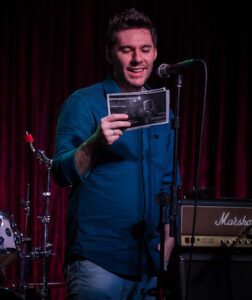Those who start studying singing soon come across the terms head voice, chest voice, mixed voice, falsetto, whistle voice, etc. Many vocal coaches try to perfectly define these terms (including physiological definitions, referring to musculature) and pass this on even to students who want to sing as a hobby.
All of the terms listed above have to do with vocal registers. What is their importance in singing? And everyone who wants to learn how to sing needs to know everything that happens physiologically? Is singing falsetto wrong? Who has a cool and powerful high note is singing in the chest voice?
First, what you will read next is ONE of the visions. There is no complete consensus on the topic and even today many vocal coaches, speech therapists and otorhinolaryngologists around the world study the subject in a very seriously and deeply.
Good, but what about the registers?
A very simplistic definition is that register is “a consecutive series of tones with similar properties”.
From a scientific or laryngeal point of view, register is a consecutive series of tones produced with the same mechanism.
From a singing or acoustic/perceptual point of view, a register is a consecutive series of tones produced with a similar vocal quality.
Scientific point of view
Let’s adopt the concept of Minoru Hirano (1974) who introduced the concept of Body-cover (body-cover) in the anatomy of the vocal folds where Cover consists of the upper two layers of tissue and Body consists of the lower three layers of tissue – totaling five layers .
We can define registers according to which parts of the fold are vibrating:
- M0: where Body and Cover are loose;
- M1: where Body and Cover vibrate;
- M2: where Body no longer vibrates;
- M3: where the vocal folds are very thin and tightly stretched, only Cover vibrates and often there is incomplete fold closure.
In more familiar terms:
- M0: vocal fry or pulsatile register;
- M1: modal register or normal register or chest voice / mix voice (mixed or middle voice)** / head voice*;
- M2: head voice* (falsetto – see below) / mix voice (mixed or middle voice)** ;
- M3: whistle voice or whistle register.
* Depending on the terminology adopted, head voice fits either M1 or M2 (more details below);
** The mix voice (mixed or middle voice) appears in both M1 and M2 for reasons other than the head voice. In this case, the singers really can access this coordination in different ways.
Singing or acoustic/perceptual point of view
Here things can vary a lot because the sounds of each individual depend a lot on the shape of their vocal tract. Timbre and intensity often mislead our perception too.
Many terms remain subjective from the singing point of view, despite that, we think it’s important to discuss the terms chest, head, mix, falsetto etc with you because many learn mainly through acoustic, perceptual and sensory feedback. But make sure you know exactly what these resulting sounds are in your own voice.
It’s important to remember that the entire voice is produced in the vocal folds. The vibratory sensations (and resulting nomenclatures) can be felt in the head, chest etc by resonance phenomena.
As general guides, we could use:
- Fry: is the lowest register. The name in English has to do with something frying (bubbling) in the pan. Used for example by Tibetan monks to sing bass below their “normal” voice range. Some singers, especially in country music, use it as a way to start a low note. A really cool use for it is when the person has an weak low end in their voice;
- Modal: also called normal exactly because this is where most of people’s spoken and singing voices are concentrated. We here at the studio like to subdivide this record into: chest voice, mix voice (mixed or medium voice) and head voice. The idea is that low notes are concentrated in the chest resonance, middle and mid-high notes (when we want power and greater emotional engagement) are in the voice mix – a mix of a little chest, a little head, a little resonance pharyngeal and maybe a little compression – and finally, the highest notes concentrate on the head resonance;
- Falsetto: production in which the voice has a sound similar to the sound of a flute. The term falsetto comes from Italian as a diminutive of the word false. Hence, perhaps, comes a large part of the prejudice regarding this term as if it did not belong to a person’s voice or that even if it would be wrong to use this vocal production. Pop music is full of examples of falsetto;
- Whistle Voice: It is the highest register. The term comes from English because in this production there is the idea that the voice is very high and strident resembling a whistle. Very little used in music, but there are examples of this production in some Mariah Carey songs.
The modal register and mix voice deserve a separate post. This was just a general brushstroke.
Falsetto or head voice?
In the previous discussion, head voice can appear in both M1 and M2.
This is an eternal battle, maybe even we will make another post (how many extra posts, right?) exclusively about this so we don’t overload this one, but in a very simple way: there is a line of thought that says that head voice is fuller and that the falsetto is characterized by an excess of breathiness. Therefore, you would have much more dynamic control (of intensity – strong and weak) when in the head voice. It is more difficult to control the falsetto pitch also precisely because of the excessive breathiness.
We here at the studio tend to agree with this current for practical purposes. In this case, head voice would be in M1 and falsetto in M2.
One more essential thing we stand for here in the studio is that there is only one mistake when it comes to singing: getting hurt (short term and long term). Other than that, the rest are choices you make. They can be good or bad choices and as you mature musically and advance in vocal technique studies, you might even change your current choices. It is also important to evaluate the postures you are adopting through feedback.
In a technical and simple objective, we must, while studying and in a first moment, seek balance in the voice. Imagine a gradient of colors where one color transitions into the other as smoothly as possible – we should have that in relation to vocal registers as well, as we go from low to high and back from high to low notes.
But of course this has a lot to do with the style of music you’re singing too. So maybe you’re not getting hurt now or you won’t get hurt in the future, but in some cases you might not be matching the most common characteristics of that style. We could even classify this as a stylistic mistake .
Finally, it may not be necessary for you to know all the nomenclatures and musculature involved. It depends on your goals, it depends on the way you learn things, it depends on whether you are a more intuitive person or if you are managing to evolve through monitoring your voice (in recordings or with a microphone directly connected while you sing).
What we have noticed that works best is when students understand the objectives of the vocal exercises (and activities in the repertoire) and practice these exercises and activities regularly and pay attention to the posture found during class.
The information contained in this post and those that are more theoretical given in class should only serve as guides and complements. A speech therapist or ENT may know exactly (better than singing teachers) what happens in the human body when we sing, but even if they want to learn how to sing well, they must practice like everyone else.



